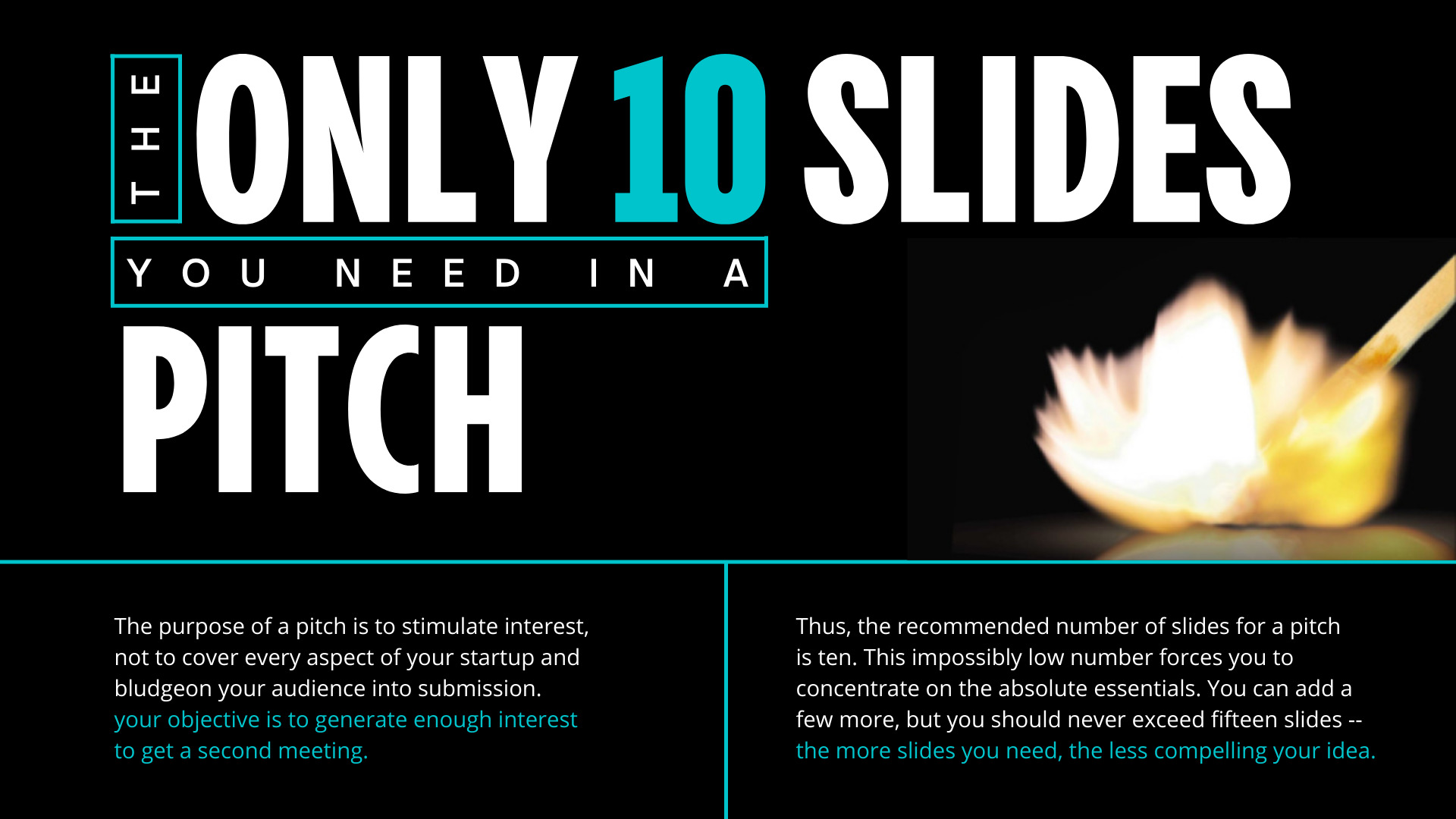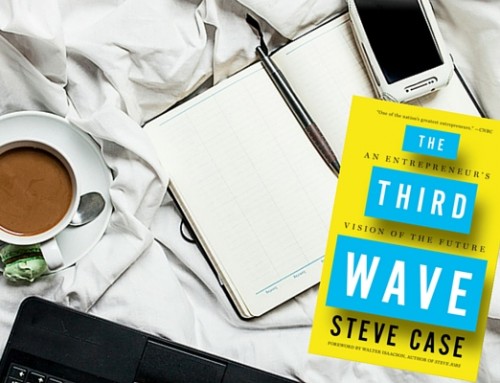I am evangelizing the 10/20/30 Rule of PowerPoint. It’s quite simple: a pitch should have ten slides, last no more than twenty minutes, and contain no font smaller than thirty points. This rule is applicable for any presentation to reach an agreement: for example, raising capital, making a sale, forming a partnership, etc.
- Ten slides. Ten is the optimal number of slides in a PowerPoint presentation because a normal human being cannot comprehend more than ten concepts in a meeting—and venture capitalists are very normal. (The only difference between you and venture capitalist is that he is getting paid to gamble with someone else’s money). If you must use more than ten slides to explain your business, you probably don’t have a business.
- Twenty minutes. You should give your ten slides in twenty minutes. Sure, you have an hour time slot, but you’re using a Windows laptop, so it will take forty minutes to make it work with the projector. Even if the setup goes perfectly, people will arrive late and have to leave early. In a perfect world, you give your pitch in twenty minutes, and you have forty minutes left for discussion.
- Thirty-point font. The majority of the presentations that I see have text in a ten-point font. As much text as possible is jammed into the slide, and then the presenter reads it. However, as soon as the audience figures out that you’re reading the text, it reads ahead of you because it can read faster than you can speak. The result is that you and the audience are out of synch.
I hope this helps you create a winning pitch deck for your startup. If you’re interested in this template, you’re probably an entrepreneur. Please check out my podcast, Remarkable People, to learn from remarkable entrepreneurs such as Steve Wozniak (Apple), Melanie Perkins (Canva), Suzy Batiz (Poo Pourri), Steve Wolfram (Mathematica), and Melissa Bernstein (Melissa and Doug).




Very good points. Sometimes less is more, especially when you are trying to get important points across and increase your credibility.
I fully subscribe to this logic…just find it interesting that were you to convert this excellent info-graphic to slides it would equal approximately 15 slides.
Your presentation is meant to support the message you’re communicating, not obscure it. I can’t agree with the thought ” a normal human being cannot comprehend more than ten concepts in a meeting “. Using more than ten slides to explain for my business may not break my standard level.thanks
Very good simple and pragmatic tool useful in various domains. I see many applications for NGOs either with policy makers or donors. We need more of those to help them integrate private sector good practices, and hence gain in professionalism, impact and coherence.
Why is this not the template used for Shark Tank?
HA! This is the exact same template used for Shark Tank, minus the deck / linear format. Otherwise, all these topics are the key focal points of their discussions.
Loved this article especially the part about “using a Windows laptop, so it will take forty minutes to make it work with the projector” .. hehehe!
I love this article. However, this comment ( his comment ) is unnecessary and distracting – it could have been eliminated and the article would be even stronger. I’ve been burned enough times with projectors and Apple computers that I rigorously avoid them – a personal choice. Yet, I wouldn’t have injected my bias about Apple into this article if I was wrote it. In ‘ The Art of the Keynote Guy says ‘ Don’t denigrate the competition ‘ – good advice. Apparently Microsoft is the competition. He should follow his own counsel.
And the reality is it’s true you wouldn’t spend 40 minutes trying to get it to work with an apple. You’d realize immediately you don’t have the right adapter that’d be that.
I didn’t get past the first line because the phrase is “in a pinch” not “pitch”.
Peggy is this a joke? The author is referring to a sales pitch. There’s no such thing as a “sales pinch.” He’s not referencing your phrase.
Only one slide is missing… Defensibility & IP. Every good pitch has some sort of moat. Trade secrets, patents, exclusivity agreements, etc. Investors want to have some sort of competitive advantage and protections.
Same goes for sales pitches.
Brian – wouldn’t that would be in the Underlying Magic?
Dave – Not really. The underlying magic is your “model”; what are you doing differently to address the need in the market?
As an investor, you want exclusivity in the market to that magical way of addressing the need. That means you have a legal way to defend the IP (e.g. patents, copyrights, etc.). With those elements your execution in fulfilling the need becomes less important, and thereby reduces investor risk, because in the end we can then license the IP to someone who can.
How would someone protect a big idea let’s say as example the idea of Facebook. A network idea. A big idea, but one that could be grabbed and replicated.
How do you protect “the idea” even from those angel investors you are pitching to?
Do you ask investors to sign anything before you pitch?
I am stuck at this very fundamental starting point.
I agree. This is where I am stuck. My business model and idea are based around a network sales concept and exclusive market niche (a huge niche).
How do I protect that?
Do I need to protect this idea, even from presenting to investors?
How do you protect a network concept, for instance how would you have protected the idea of Facebook going in to present the concept to investors?
Is stealth, speed of execution, launch and quick scaling the only ways?
@Briand and Dave, What I recall from the book, Underlying Magic refers to differentiation; which can take the form of IP, unfair advantage or innovative resource/model.
Great Article. I completely agree with Guy, the attention span of most people is max 20 minutes after which the human mind has moved on. the slides may be more than 10 but really your message is only heard in the first 15 to 20 minutes. Lol so agree with the 40 minutes set up time :) that is something we see all the time..
Great article! nice to read. is there any example or presentation, if you have please share with us.
I would add use of pictures and graphs along with text in the presentation. Pictures catch great deal attention and they communicate well. I would also add presenter’s voice pitch and connecting with audience while presenting.
Guy’s 10 slides are clearly structured as a pitch presentation format for investors. Having now been on both sides of the table, I can confidently say they are an effective template / discipline for getting your story focused on the essential check list of questions that investors will have, for keeping their attention, and for whetting their appetites to want to learn more .. and potentially attracting a champion in the process. With a strong leader taking command of the presentation, these guidelines work well for improving your batting average attracting $. As Mark Twain said, “If I had more time I’d have made it shorter”. If that was ever more true, it’s with investors who are barraged daily with deals.
Love the 10/20/30 philosophy and am rewriting an article => video to follow.
Some of the comments make me a bit concerned though.
some wat to relavent about internation affairs of nationality inthe antise social group….!!!!
What is your take on the PechaKucha format of 20 x 20 – 20 slides , 20 seconds each? In a world of decreasing attention spans do you think this format has the ability to add a bit more Zing and Energy to a presentation?
Allows more time for Q & A then too.
This is very, very helpful to me in creating my pitch.
This is realy helpful I using the same in my studies here in Kenya
Thank you GK, I used it. I raised capital for my young company.
Very good simple and pragmatic tool useful in various domains. well elaborated design and understandable.
Funny thing is, I am using Canva for a project presentation in a Strategic Sales class and this was the first useful article I found to help me get a start on it.
I can agree with this as someone who make many pitch decks. I like the idea of 10, but it is not feasible as there is no consumer insight, media quotes, simple marketing plan, etc. Yes. there should be 10 topics, but that does not mean 10 slides as some topics do take multiple slides, even if just a media coverage quote on a slide to introduce a topic.
Guy Kawasaki pitch deck are very small but very helpful for startup, however have a look this one pitch deck,
https://goo.gl/QaCrPT
it have 450+ slides cover all the topics of every pitch. 6 categories template such as marketing, sales, investor, startup,
I think it’s interesting that “Exit Strategy” is a stupid question. Perhaps what Guy is saying is the “Underlying Magic” is the exit strategy?
I really like the book The art of start 2.0. He explains in simple words and its easy to understand. I recommend the book!
I agree with Guy’s thoughts. In addition: Make up a deck. Show it to a friend. Then 2 days later ask them what it said. Tweak the deck so that the viewer is left with 3 or 4 most important bullets. These should be very much akin to the notions in the Elevator Pitch.
Does anyone have any good examples of anyone using this format? It would be nice to see this applied.
People invest in people so my pitch decks, based on Guy’s approach, have the team slide in position #2. The 3-4 key individuals are listed as follows:
Joe Shmo
Head of Engineering
Cal Berkeley – MS Computer Science
Previously VP Engineering @ Lightning Networks (acquired by Cisco)
Driving product development
I don’t make a big deal about the CFO and never use “R&D” in the pitch. VC’s early on dictate who the CFO is, and one VC told me years ago that “research is done in universities, not with my money”
Limit of 10 slides enforces you to be concise, to see and display a core of the project. And it is critical to be understandable for audience. When you don’t spend additional time of investors, they see that you respect them. So they will respect you.
I’m looking for a pitch deck for a veterans non-profit.
Hello every body,
I’m a senior counselor for entrepreneurship and business in knowledge-based as well as normal habitant civil services. In my opinion, the very pre-condition for any good presentation is good idea with tested de-coupled sub-phases of the business. The investor and his/her venture capitalist is plausibly expert to capture the subject.
If you don’t have a great and sizable business idea don’t expect that you will win with any trick such 10/20/30. These rules are suitable for great-idea owners.
One of my ask for pitch deck. Your advise on pitch deck relief me from the pressure.But when i started to do the pitch deck , it takes 3 hours to complete and i made only 8 slide. I realized that i am weak at PowerPoint presentation. Can you release a course on power-point?
Thank You
Valuable help for all our startups.
The article is very well written; short but useful. Thanks for sharing such a useful piece of content.
Guy, I love this format and I push it on all the entrepreneurs I coach. As I’m prepping to give a presentation and share it though, I see that the infographic form is actually impossible to present in PPT. Text is too small and formatting isn’t right. Seems like the infographic needs a little rework to be most useful!
Very well written article. Thanks for sharing such a useful piece of content.
Beautiful Article, Guy! Short and to the point and explained your points with proper justification. Rhyming concept 10/20/30 too.
Minimalism at its finest. 10 slides felt a bit less at first but the infographic made things very clear.